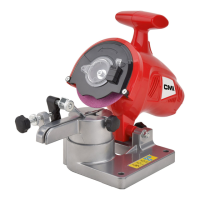GB
24
Removing and installing grinding wheel
► P. 5, item 10
– Turn the moveable hood (3) to the side.
– Keep the spindle lock (23) pressed and loosen
the clamping screw (21) by turning it counter-
clockwise with the enclosed Allen wrench.
► P. 5, item 11
– Remove the tensioning flange (20) from the motor
shaft.
– Remove the grinding wheel (22) from the engine
shaft. The rear flange stays on the engine shaft.
– Mount the grinding wheel again in reverse order
of the operating steps. Make sure the wheel
flange is in the right position (► P. 5, item 12).
Troubleshooting
Malfunctions are often caused by minor faults. You
can easily remedy most of these yourself. Please
consult the following table before contacting the ven-
dor. You will save yourself a lot of trouble and possibly
money too.
If you can’t fix the fault yourself, contact your nearest
vendor. Please be aware that any improper repairs
will also invalidate the warranty and additional costs
may be incurred.
Disposal
Disposal of the appliance
A crossed-out wheelie bin icon means: Bat-
teries and rechargeable batteries, electrical
or electronic devices must not be disposed of
with household waste. They may contain
substances that are harmful to the environ-
ment and human health.
Consumers must dispose of waste electrical devices,
spent portable batteries and rechargeable batteries
separately from household waste at an official collec-
tion point to ensure that these items are processed
correctly. Information on returning these items is
available from the seller. Sellers are required to
accept these items free of charge.
Batteries and rechargeable batteries, which
are not permanently installed in waste elec-
trical devices, must be removed prior to dis-
posal and must be disposed of separately.
Lithium batteries and battery packs in all systems
must only be retuned to a collection point when dis-
charged. Batteries must always be protected against
short circuits by covering the poles with adhesive
tape.
All end users are responsible for deleting any per-
sonal data stored on waste devices prior to their dis-
posal.
Disposal of the packaging
The packaging consists of cardboard and
correspondingly marked plastics that can
be recycled.
– Make these materials available for recy-
cling.
Technical data
*) The specified values are emission values and do not necessarily represent
safe workplace values. Although there is a correlation between emission
and immission levels, this cannot be used to infer whether additional safety
NOTICE! Risk of damage to workpiece!
With increasing abrasion the grinding wheel
diameter becomes smaller and the wheel
must be replaced.
Minimal diameter: ► Technical data – p. 24
DANGER! Risk of injury! Observe rotation
direction when installing grinding wheel. The
rotation direction of motor and grinding
wheel must correspond.
DANGER! Risk of injury! It must be possi-
ble to lightly slide the grinding wheel onto
the engine shaft. Do not force the grinding
wheel on or drill on.
After every grinding wheel mounting carry
out a test run without load.
DANGER! Risk of injury! Unprofessional
repairs may mean that your unit will no
longer operate safely. This endangers you
and your environment.
Error/Fault Cause Remedy
Device does not work No power supply? Check the cable, plug, and the fuse.
Insufficient sharpening capacity Grinding wheel worn out? Replace grinding wheel (► Remov-
ing and installing grinding wheel –
p. 24)
Grinding wheel buckled?
Device vibrates strongly
Grinding wheel incorrectly mount-
ed?
Mount grinding wheel correctly
(► Removing and installing grinding
wheel – p. 24)
Item number 234855
Rated voltage 230 V~, 50 Hz
Capacity 250 W
Idle speed 8400 min
-1
Protection class II
Dimensions of grinding wheel ø100 × 3,2
× ø10 mm
Sharpening angle +35°…-35°
Sound output level (L
WA
)* 93 dB(A)
K = 3 dB(A))
Sound pressure level (L
PA
)* 82 dB(A)
K = 3 dB(A))
Vibration** 3,274 m/s²
(K = 1,5 m/s²)
Weight 1,5 kg

